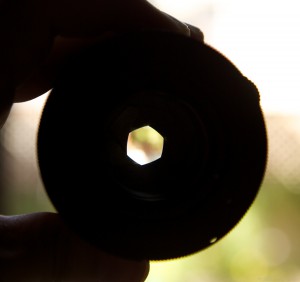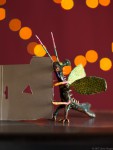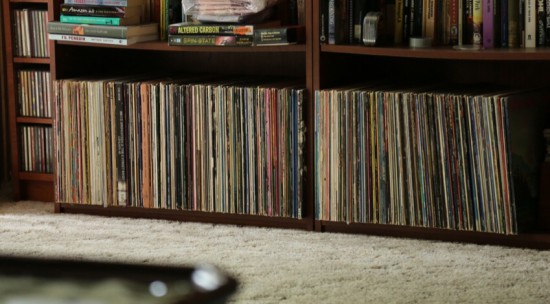This is filed under the long-neglected ‘Get Poor Quick’ category, but the means of getting poor follows a discussion of camera lenses in general, with an emphasis on bokeh. Follow me and we’ll turn the whole industry on its head!
I was futzing around with the ol’ camera today, playing with my MIR-24, an older lens in which the Russians one-upped the prestigious German lens they were copying. I wasn’t trying for great photography, I was getting to know my lens by taking a bunch of pictures. It’s a fun lens when one has the time to manually get the focus just right. Here’s one of the shots I took (click to biggerize):

One of the things I like about this shot is the way the fore- and background are interesting without being distracting. I took the shot with the lens wide open, which narrows the range that is in focus, and makes the foreground and background nicely blurry.
Different lenses will blur things differently; the quality of the blur is referred to with a word bastardized from Japanese, “bokeh”. Good bokeh is often described as “smooth”, while “jittery” is often used to describe bad bokeh.
But neither of those words actually describes what qualities make bokeh good or bad, just how it makes us feel. There is one generally-accepted reason bokeh is good or bad, and two others that are just as important but are not mentioned nearly often enough. I’m here to straighten that all out. You don’t have to thank me, it’s what I do.
So let’s think for a moment about what blur actually is. An image is blurred when light from one point in the subject covers more than one point in the image. Think about pictures where lights in the background turn into little circles. Or, if you don’t want to take the trouble to think, here’s an example:

Note that points of light in the background of the above image are turned into circles. This is a projection of the aperture onto the camera sensor. If you look really closely, in fact, you will see that they are not quite perfect circles, but rounded octagons. The lens I was using has an eight-blade aperture control.
[Side note: When I’m watching TV now, I always take an interest in the shape of distant lights during night scenes. I bet an experienced cinematographer could tell you exactly what lens is being used just by that shape.]
Everyone agrees: the rounder the aperture, the smoother the bokeh. This is mostly true, but it’s far from the whole story. Here’s a look down the barrel of my MIR-24:

The aperture is a hexagon, and not a terribly symmetric one at that. So, as the lens is stopped down (the aperture is closed) the bokeh will start to look edgy, and the dots from distant lights will be hexagonal. (The shot of the critters above was with the aperture all the way open; the blades are pulled out of the way entirely and the aperture is a nice perfect circle.)
Before we go on, let’s have some fun with aperture shapes!
Just because there’s an aperture control inside the lens, doesn’t mean we have to use it! Here I shoot with my beloved 85mm f/1.2, wide open in all these shots. But in the second shot, I’ve added my own homemade aperture in the shape of a triangle. (I wanted to do a fancier shape, but I’m not that good with the x-acto.)
-

-
Lens wide open
-

-
My homemade aperture
-

-
Triangles!
You can get kits with all sorts of fun shapes, or you can get a camera lens with my new idea built right in. (Well, you might have to wait a while for option b.) Read on!
Back to bokeh. We have the generally-agreed-upon axiom that round apertures make better bokeh. But there’s another factor: The structure of the dots themselves. Some lenses produce nice, even dots, while others produce dots with a bright rim around the outside. And you can see that my homemade triangle aperture produced pretty significant ghosting. Both those things will add to the general unpleasantness of the blurry parts of your photos. So don’t assume that that old lens with the 20-blade aperture that’s nearly a perfect circle at any f-stop will automatically give you good bokeh.
Then there’s the one factor that no lens can compensate for (yet…). Sometimes the subject matter just doesn’t blur well. Here’s a picture that demonstrates a couple of annoying bokeh traits even when the lens is doing its job relatively well:

The first bokeh annoyance is the fungus in the background. The fungus is very structural, but the way it blurs just doesn’t feel natural. Behind the fungus things get muddled but also don’t feel quite natural. To see why the blur came out the way it did, consider the blade of grass that goes diagonally behind the flower. It is blurred into a perfect, straight, well-defined, sharp-edged area of doubt and uncertainty. All the things that go into a traditional aperture to create “good” bokeh sometimes produce a result that doesn’t feel natural. Lines get exaggerated rather than softened. The line of the grass becomes a line of circles, the light evenly distributed.
The big distracting leaf in the foreground cannot be blamed on the lens, alas. You have no idea how many different crops I tried to get that MF-er out of there.
OK, we’ve finally made it to the get-poor-quick part of this episode. You see, I have come up with a way to control the aperture of the lens that solves ALL the above problems: the aperture can be perfectly circular at any f-stop, or it can have any shape the photographer wants.
The blur in a traditional lens has hard edges because the aperture has hard edges. Metal blades close and open to allow more or less light into the lens. But what if the aperture were not hard-edged? What if the hole that let light through tapered off in opacity toward the edges? Those circles projected onto the sensor would taper as well, softening the edges of the circles, and therefore softening the bokeh. It would look fantastic.
All we have to do is get rid of those dang metal blades and replace them with a ridiculously high-resolution grid of pixels that can be set on a continuum from completely transparent to utterly opaque. The rest is software.
I know that is easier said than done, and even with the march of digital progress the resolution required for this project (a couple of orders of magnitude better than what we could do now – getting down to an almost atomic scale) is a long way away. Or maybe, (better yet!), it’s not digital at all and an electric field could be applied to a film of material that controlled its opacity.
Eventually a system like this will be far cheaper to manufacture than a mechanism with servos and metal blades, and it will add a softness to pictures that can only be dreamt of today.
 1
1
Sharing improves humanity:









